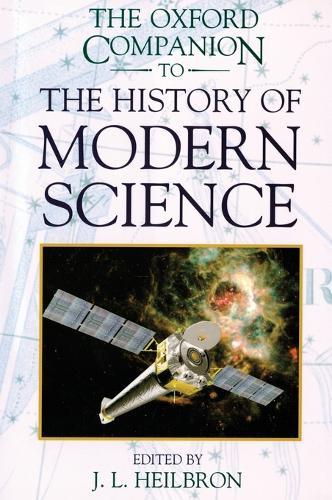Full Product Details
Author: John L. Heilbron (, Professor of the History of Science Emeritus, University of California at Berkeley)
Publisher: Oxford University Press
Imprint: Oxford University Press
Dimensions:
Width: 25.40cm
, Height: 6.60cm
, Length: 19.10cm
Weight: 1.828kg
ISBN: 9780195112290
ISBN 10: 0195112296
Pages: 994
Publication Date: 17 April 2003
Recommended Age: From 13 to 17 years
Audience:
General/trade
,
General
Format: Hardback
Publisher's Status: Active
Availability: To order

Stock availability from the supplier is unknown. We will order it for you and ship this item to you once it is received by us.
Reviews
This volume is the culmination of much scholarship and enormous effort.... The result is delightful to browse... --Nature<br> The Oxford Companion to the History of Modern Science has great breadth, it contains numerous entries that are a pleasure to read, and its index makes it easy to use. --Times Literary Supplement<br> Oxford's Companinion credibly covers the history of science in one volume. Accessible as well as scholarly, the work covers modern science but includes events that date back to antiquity and Aristotle, though much of the material begins in the 17th or 18th century...The quality of writing is excellent and the distillation of the history of science skillful. --CHOICE, T. McKimmie<br>
The story of the history of science has many beginnings. Geometry was founded by the ancient Greeks and astronomy has its roots in ancient China, while quantum mechanics and genetics are disciplines that started only in the 20th century. The word 'scientist' has only been in use since the mid-19th century; Isaac Newton referred to himself as a 'natural philosopher' although his work became one of the cornerstones of science. Taking the mid-16th century as its starting point, the Oxford Companion to the History of Modern Science focuses on the era when science began its rise to the powerful position it occupies today. Biographies of scientists, explanations of scientific subjects and concepts and descriptions of scientific instruments, all clearly written, form the majority of the entries, but there are also broader and very readable essays exploring the wider context of science in society, including 'Science Fiction', 'Gender and Science', 'Slogans from Science'. The degree of expertise required to appreciate the entries varies widely, from the easily understandable 'Age of the Earth' to the impenetrable 'Quark', which condenses an explanation of subatomic particles into a column and a half. This is a book which it is a pleasure to dip into at random. Accessible and useful to both the lay and scientific reader, it includes some refreshing humour and many personal stories of science and scientists. Entries are cross-referenced to other entries but if you are searching for a particular topic the generous index at the back offers the best way of tracking down information. There is a sprinkling of black-and-white illustrations among the text and a few pages of captioned colour pictures. (Kirkus UK)



